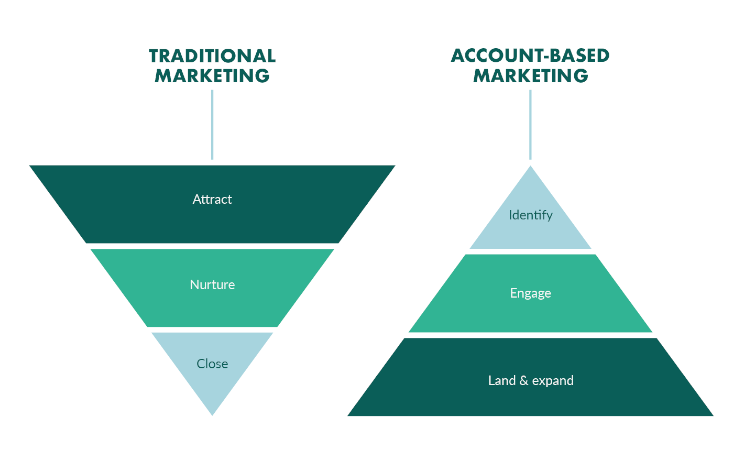If you’ve heard the term “account-based marketing” or “ABM” and have been wondering if it’s something you should try, then this is the primer for you.
After all, 97% of marketers who use this method reported seeing a higher return on investment (ROI) than with any other method! That’s not just impressive, it means ABM is practically a necessity for businesses if they want to stay competitive.
This account based marketing guide is going to be a deep dive into all the ins and outs of what ABM is, how it works, and how to get started doing it yourself.
What we’ll cover in this guide
- What is account-based marketing?
- What are the benefits of account-based marketing?
- What are the limitations of account-based marketing?
- How to get started with account-based marketing
- Key account-based marketing questions answered
- Start getting your account-based marketing strategy off the ground.
What is account-based marketing?
When 67% of brands are leveraging an account-based marketing approach, it just makes sense to understand what it is. We’re going to be defining account-based marketing, talking about who should use it, and discussing its goals.
Account-based marketing tailors your marketing efforts to target specific accounts, rather than large, broad groups. Essentially, you look at your clientele and instead of digging into demographics, you select specific companies — or even individuals. This means creating significantly more customized campaigns so you can speak more directly with the exact people or companies you’re targeting.
To get a clearer picture, look at this diagram of how account-based marketing works:

It’s an inverse of the more traditional sales funnel that has you casting a wide net and narrowing your scope as you move through the process. Instead, you choose your specially selected targets and then ramp up and expand from there.
This process is also known as the “land and expand” method. This means you focus on landing a client (or looking at a relationship with a client you’ve already landed) and nurturing that relationship to encourage more sales (expand) down the line. This could be more sales with that specific relationship or expanding out to make use of your client’s network, driving more business for yourself.
Who is account based marketing for?
It may seem like the account-based marketing approach is only for big businesses looking to land major corporations as clients, but that’s not true. ABM practices can be adopted by just about anyone, as long as you know how to apply them. The only thing you might need to do before you can start is a small amount of research.
You’ll want to have a good understanding of your answers to the following questions:
- Who is my current client base?
- Who are my top clients?
- Where would I like to expand in the future?
Once you have a thorough understanding of these key pieces of information, you’re ready to move forward!
The goals of account-based marketing
The goal of account-based marketing is simple: to increase your revenue and build strong client relationships. That may seem obvious, but it just goes to illustrate why ABM shouldn’t intimidate you: its main goals are the same as just about any other marketing technique!
More specifically, though, you can also use ABM to increase the data you have about specific customers, nurture and strengthen existing relationships, and even set yourself apart from some of the competition. In short, it’s an important piece to a healthy and robust marketing strategy.
What are the benefits of account-based marketing?
The benefits of account-based marketing are much farther-reaching than increased efficiency (although that’s definitely still part of it). You could see everything from a boost to customer loyalty to having better metrics to study down the line.
1. Increased loyalty across your customer base
One of the biggest benefits of an account-based marketing campaign is that it can not just lead to sales, but increased loyalty among your consumers. How? Personalization! You can’t run an effective ABM campaign without tailoring it to your target audience, and content that’s better suited to match that audience’s needs performs better.
You don’t want to go too far, of course — when marketing is too personalized it can backfire. But that should be pretty easy to avoid here! After all, we’re not trying to market to people by knowing everything about their lives. The way you should be tailoring your campaign is by focusing on specific problems your audience is having and how your products can solve them.
2. Cost-effectiveness and efficiency
While it’s possible that mass marketing efforts can be cheaper than ABM, and are certainly less time intensive, they aren’t as effective. Sure, you could send your marketing efforts to everyone in your city, but a bunch of that effort will be wasted on people you already know aren’t interested in your product.
By focusing your efforts on a specific set of customers or potential customers, you can increase your efficiency without necessarily increasing your cost. Even if you spend more on an ABM campaign, you’re far more likely to see a lower CPA (cost per acquisition).
That means the extra time it can take to put together this kind of marketing strategy may end up paying for itself!
3. Clearer path to ROI
Figuring out your ROI can be a little tricky depending on your marketing practices. But one of the unsung perks of account based marketing is just how simple it becomes to see your ROI. It’s a simple practice of calculating your money-out vs. money-in.
Because you’re looking at your accounts as single, marketing entities, it becomes much clearer to see exactly how much you spent on messaging. In turn, it’s equally simple to see exactly how much you made. Now that you understand the benefits of account based marketing, you can dive into why microsites are an integral part of ABM strategy.
4. Close more high-value deals
Because ABM tactics can make your team and your business more efficient, that can lead to the additional benefit of being able to close more high-value deals. When your sales reps are able to focus more clearly on large, high-value accounts, they can afford to use a more custom approach. You can set yourself apart from your competitors as you more specifically address your target’s needs.
When you consider that 56% of marketers say personalized content is critical to a successful ABM strategy, it makes a lot of sense that it could help you close these high-value deals.
5. More in-depth metrics to analyze
Tracking your business metrics, such as growth, churn, and customer acquisition cost (CAC) might seem like a no-brainer, but with an ABM strategy, these metrics are only scratching the surface of what you can learn. Instead of looking at your sales numbers as a whole, you’ll be able to separate them out on a far more individual level. That means you’ll be able to collect far more specific and accurate information.
For instance, if your overall sales numbers appear steady, you might be inclined to assume everything is going swimmingly. But by examining your accounts separately, you might discover a trend or pattern where perhaps one large account is making up for the poor performance of other, smaller accounts.
What are the limitations of account-based marketing?
While account-based marketing can lead to immense success for your team or company, that doesn’t mean it’s without its potential drawbacks. ABM is still incredibly valuable, but you should go in expecting some challenges. Let’s take a look at a few of the most pressing.
1. It’s resource and time-intensive
Mounting an ABM strategy is going to take time and resources. You need to have room in your budget and your headcount to handle the diligent research required to bring in new business. If your company is small, it could be unfeasible for you. It’s also not a strategy that can be rushed as a last-ditch effort to turn a quarter around. ABM is about building relationships based on knowledge of your target, and that doesn’t happen overnight!
2. It can narrow your reach
Part of ABM is all about specificity in your marketing and outreach efforts, but that can put you at risk of narrowing your reach too much. If you’re focusing on ABM at the expense of your broader marketing, it’s possible your performance could take a hit. That’s part of what’s so difficult to balance. You need the resources to manage both your individualized efforts and your broader marketing strategies to be truly successful.
3. Measuring success can be more complicated
While the influx of data you can obtain from ABM can be incredibly helpful, it can also make measuring your success a little more difficult. There are many more individual factors that your data sets can take into account and that can be difficult to manage. It’s especially difficult if you’d previously been used to only viewing one, broad set of data.
4. Lack of alignment between teams can derail your efforts
More teams are involved on a more intricate level with account-based marketing. If your marketing and sales teams aren’t properly aligned with a free flow of information, it can lead to some major hiccups for your strategy. It’s important to make sure all parties, from marketing to the sales reps and account managers are all aware of what’s going on at any given time.
Now that you understand the benefits and drawbacks of account-based marketing, you can dive into why microsites are an integral part of ABM strategy.
How to get started with account-based marketing
Ready to keep that ABM train rolling? We’ve got a few simple steps on how you can get started on launching your own (maybe even your first) account based marketing campaign.
1. Research, research, and more research
An easy place to start with your research is to start drilling down into exactly who is visiting your website. Choose a visitor identification program to help you determine how long certain visitors are staying on your page and where they’re coming from.
You can also turn to the tools you’re already using such as your email list and CRM software. Start compiling this info with what you’ve gathered from visitor ID trackers and you’ll be well on your way to understanding not just who you’re talking to, but which of those people seem receptive to the message.
It’s important to keep in mind that specificity is the goal here so if your research takes a bit more work than you’re used to, that’s to be expected! Your chances for success may be higher the more you learn about your targets because the more you learn, the more tailored your efforts can be.
2. Organize your list of prospects
Once you know who’s visiting your site, it’s time to break them down into categories ranked from most likely to buy to least. Now you can organize a true plan of attack by going after those who rank the highest in your research. After all, you wouldn’t want to waste time by focusing blindly on those who might be coming to your site in error!
And once you’ve organized your prospects by priority, you can create detailed account plans for them. That means considering which channels each prospect may be the most receptive to (digital ads, direct mail, content creation, etc.) and tailoring your approach that way. There’s likely to be some overlap, of course, but the key is to address each prospect on an individual level.
3. Start creating content
This step is the heaviest lift, but should ultimately be the most fruitful. Now that you’ve got a rich and detailed portrait of the potential customer you want to talk to, you need to start talking. That means determining what problems they might be facing and how your product specifically can help. You don’t have to worry about speaking “to the masses”; just focus on your target.
A great way to do that is to create landing pages and microsites that seek to answer questions these prospective customers might have. If you can provide genuinely helpful information these people find useful, you’re probably not far off from watching the cash roll in.
As you create and customize your content for each account, remember to keep sales and marketing fully aligned. The sales team may have further insights into what customers want that marketing can leverage to make sure the content they make is as aligned with potential customers’ needs as possible.
4. Prioritize the most lucrative channels
As you tackle each account, organize and prioritize their channels the same way you did for the accounts themselves. That means you’ll want to prioritize the most lucrative channels, which might vary between accounts.
For some, these might be the heavier lift channels such as custom blog content and even in-person events. For others, you might be seeing the most traction from simple efforts like digital ads and direct mail.
Whatever the case may be, once you understand where you’re seeing the most success, this is where you’ll want to focus your efforts on for each account. But remember: that doesn’t mean you should let your other efforts fall by the wayside! The key to a good ABM campaign is how you balance multiple channels per account.
5. Build strong relationships with key contacts
With ABM tactics, part of your account management is about not just maintaining your relationships with your contacts, but building on them. That means striking the right balance of being in touch regularly without making the client or contact feel overburdened or inundated with calls.
Here are a few ways to do that with every account:
- People have a good radar for authenticity, so don’t try to mask your business personality. Coming across as genuine can go a long way.
- Offer what you can to help your accounts, clients, and prospects without asking for anything in return. This will earn you trust and goodwill!
- Engage with them and their content on social media. You can (if appropriate) share their posts and respond to help keep the dialogue going.
- Remember important dates like birthdays and work anniversaries so you can celebrate and congratulate them. Simple gestures like this can carry weight and help people feel seen and valued.
Key account-based marketing questions answered
When learning about account-based marketing, there are a few common questions that can arise. Here, we’ll do our best to answer any lingering questions you might have when launching an ABM campaign.
What is account-based marketing content?
Account-based marketing content is what you’ll create for each account you’re targeting. They’ll be customized not just to attract them but to help them in a tangible way. That’s the real key to ABM content strategy—you want it to actually be useful to those you want to see it, so it should be customized to their needs.
Your custom content can take a variety of forms, though, including but not limited to:
- Live content: in-person events, webinars, YouTube series, and even podcasts
- Digital content: social posts, digital ads, blog posts, and white papers
- Custom microsites: These are pages and sites custom-designed for specific accounts and can include case studies, relevant images, and more
How can I build an account-based marketing workflow?
Building your ABM workflow will start where many of the most crucial parts of ABM do: research. You’ll want to begin by creating an ideal customer profile (ICP) and work forward from there. You’ll also want to organize your teams to make sure everyone—not just your sales reps or your marketing teams—understands who the targets are and what the goals are.
That means you need to know which teams will handle which portions of your ABM campaign and then speak with your managers to make sure there are procedures in place to keep open lines of communication between everyone. If your teams were previously more siloed, this might take some extra time to do, but it’s an important step on the road to success.
What strategies make an ABM campaign successful?
There are a host of ABM strategies that you can implement. You can find many of them in this very guide, but we’ll give you three of our favorites:
- Start small, then scale up: Avoid overloading yourself at the beginning by starting with the accounts you were able to label as your priorities. This way, scaling up will give you time to iron out any kinks, whether in team structures or data collection. This means increased chances for your success.
- Customize your content marketing: As we’ve mentioned previously, customizing as much as you can can really give you a leg up. That includes your content marketing, which should cater more specifically to your target accounts’ unique needs.
- Use social proof when possible: Social proof is one of the most powerful marketing tools at your disposal, which is why it’s among the top ABM best practices. Wondering what to focus on? Case studies, testimonials, press quotes, and awards are all great places to start.
Get your account-based marketing strategy off the ground with Zoomforth
Now that you’ve got a handle on the account-based marketing basics, you can jumpstart your custom work with custom microsites. As a leader in microsite creation and hosting, Zoomforth offers the tools you need to get your ABM content off the ground.
Create, build, publish, and track the success of your ABM microsites with our easy-to-use platform. With real-time analytics, your sales data is right at your fingertips. As if that wasn’t enough, Zoomforth microsites are incredibly easy to build and maintain thanks to drag-and-drop tools and a user-friendly interface.
Don’t wait — request a demo today!



